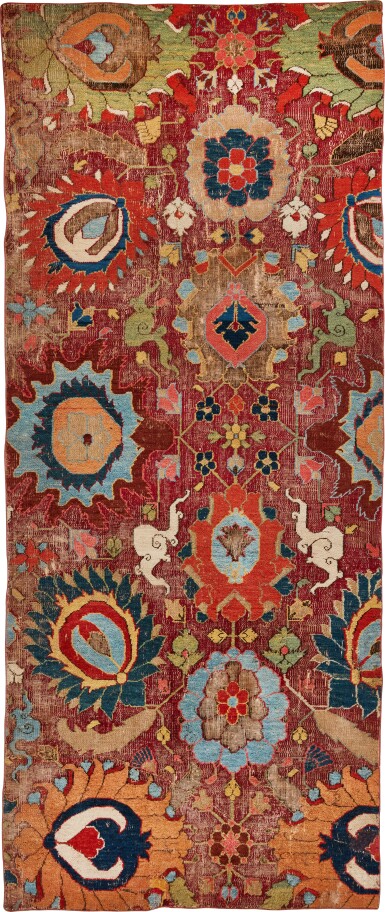Arts of the Islamic World & India
Arts of the Islamic World & India

Property from the Collection of the Late Howard Hodgkin
A Khurasan carpet fragment, North East Persia, 17th century
Estimate
20,000 - 30,000 GBP
Lot Details
Description
222 by 92cm. approx.
Ex-private collection, Germany
Sotheby's, London, 9 April 2014, lot 229.
HALI, no.180, Summer 2014, p.134
The ‘Khurasan’ group are attributed based on their technical features, which include an ivory cotton warp on two levels (also found in the ‘Vase Carpet’ group), cotton wefts, jufti knotting, and intense saturated colours. They are a very rare group of jufti knotted carpets, which are mainly known through fragments. The designs generally are derived from the Safavid Persian models, including the lanceolate leaf lattice ‘Vase-Carpets’. This fragment is of sufficient size to reveal the rhythm and balance of the design, and gives some sense of the magnificent scale of the original carpet.
For a small seventeenth century Khurasan field fragment (179 by 105cm) on a dark blue ground which shows a section of the main field including palmettes and wonderful stylised scrolling cloud motifs, see Sotheby's London, 20 September, 2006, lot 114. For other fragments of this design see J. Eskenazi, and M. Franses, Il Tappeto Oriental dal XV al al XVIII secolo , London, 1982, pp.47-48 and 90, no.29, and three comparable museum examples cited, as figs.1-3, which include a border and field fragment from the Victoria & Albert Museum, a carpet from The Art Institute of Chicago, and a small border field fragment from the Islamic Museum, Cairo.
Being rare survivors, it is enlightening when fragments show similarities in their design. There are four known fragments which allude, through their scale and rhythm, to what would have been a wonderful ‘Khurasan’ carpet, with the technical attributes required and with a design of distinctive sickle leaf motifs, and use of palmettes and smaller floral motifs and stems. For two exceptional seventeenth century border fragments, see Sotheby’s, London, 9 October 1991, lot 2 (more recently in the Talhouni Collection, Jordan; Hali, No.60, p.150) and a similar smaller fragment sold Sotheby’s, New York, 14 September 2001, lot 80 (provenance: Berdj Achdjian, Paris; Wher Collection, Switzerland and Sotheby’s, New York, 16 December 1993, lot 156). During the 1930s, a field fragment was on loan to the Victoria & Albert Museum, London, from the George Mounsey Loan 491981 – whereabouts now unknown. Another similar example of the sceptre head design was published by Bernheimer Fine Arts, London (see Hali, No.61, pp.62-63). A possible complete carpet of the same design as these fragments was sold at the American Art Association, New York, 30 April 1927, lot 1058. By repute, all four above cited fragments were cut from this carpet (see Hali, No.73, p.134). However, the design of the offered lot, whilst clearly derived from the ‘Vase’ carpets, appears to be a very rare survival of an example to include such dramatic cloud band motifs and dynamically orientated palmettes, only lightly tethered to a delicate vine trellis.
You May Also Like








![A silk and metal-thread Heriz carpet, north west Persia, dated 13[0]9/1891-92 AD](https://dam.sothebys.com/dam/image/lot/31eab780-e203-4e89-9a5e-9b415516959c/primary/extra_small)

